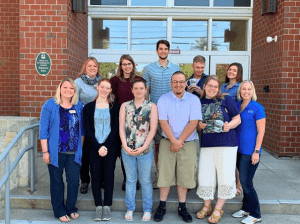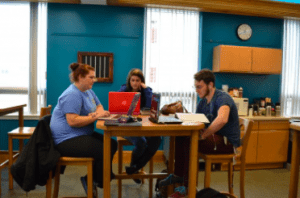
Sep 26, 2019 | Feature |
Darby Murnane, Editor in Chief

Serna aims to add diversity to the UMF community and to build strong relationships with students (Photo courtesy of UMF).
New UMF President Edward Serna envisions a future of the university which fosters opportunity for greater student diversity, career development and increased community partnerships. Serna also aims to continue work started last spring in response to Bangor Daily News articles on UMF’s handling of sexual misconduct via Title IX investigations.
Serna said he is “curious to start developing a new marketing plan and to start investing in that area,” as a way of bolstering the diversity of UMF’s student population and outreach to prospective students. Part of this marketing campaign has entailed Serna traveling to Maine high schools and community colleges where he’s spoken with principles and administrative staff.
Coming from University of Arkansas- Fort Smith (UAFS), where Serna previously worked as the interim chancellor, he said, “We had a large Hispanic population, a large Vietanmese population, representing our campus population. So I think coming to Maine, which in my understanding is the oldest and whitest state in the union, there’s some challenges there. How do you create a diverse student body when your state doesn’t represent that?”
In his conversations with community colleges, Serna indicated that there are plans to arrange partnerships between these schools and UMF as part of student outreach. “[There’s] excitement around the community colleges to even partner with us,” he said.
Serna said that it is currently unclear exactly what those partnerships would entail but there will soon be follow-up meetings to discuss possibilities.
His vision for UMF’s community involvement exists hand-in-hand with his goals for more in-depth career development. “I think our mission has to be more about career development, not necessarily that first gateway job but about putting our students in a position to have a fulfilling life and a fulfilling career,” Serna said. He’s thinking of partnering with nonprofit organizations in the area, preferably ones that students might seek employment with post-graduation, and has spoken with the Board of Visitors on this topic.
“The partnerships have to make sense for that school,” he said, “. . . .[UAFS] is very much a workforce development school. . . .This was about social mobility for these kids and a better life. So I felt it was incumbent upon me to be their advocate so they would have those opportunities.”
Serna is strategizing, with help from the new Vice President of Student Affairs Christine Wilson, to address the lingering tensions from Title IX issues of last semester. According to Serna, his and Wilson’s conversations have focused on their goal to build a specific culture on campus: “. . .a culture of healthy relationships, a culture where people feel safe from harassment or discrimination, that’s our vision.”
Wilson and Serna are attempting to follow through on the proposals brought forth by students to address these issues. “. . .there were recommendations [for a student advocate position] made by [Look Us In The Eyes],” Serna said. “Christine is now working with those recommendations to get them implemented.”
“Personally, from my office, I want to continue to make sure that Students are heard,” Serna continued, “I want to make sure there are mechanisms in place that we hear you, and that we’re listening.”
He is also planning a President’s Advisory Council student representatives to establish more direct contact and transparency between the student body and his office. Serna ideally would like to hold monthly meetings with students, staff and faculty senates individually. “I want [the student’s] voice at the table. And it’s such a valuable perspective that I don’t know how we would operate without it,” he said.
Serna issues a call to UMF students to “keep having honest conversations with me, stop me when I walk into work in the morning.”
The sense of community at UMF and in Farmington as a whole has deeply moved Serna and drives his goals for the university. “Even with the tragedy that happened recently, I think the thing that really just took Lauren, my wife, and I back was just the outpouring of support from the community and the campus,” he said.
Following last week’s explosion of the LEAP building on Sept. 16, Serna attended the candle vigil in honor of the fallen fireman, Captain Michael Bell. “I was so proud and so encouraged by the number of UMF students there. . . I think sometimes the narrative about your generation, if you will, is that you’re disconnected, you’re not part of the community. It really moved me seeing how many of us were there supporting the community on a school night if you will. My daughter was there and it was so important for her to see.”

Sep 26, 2019 | Feature |
Give Me My Dam Money! — Financial Advice
As summer passes and the temperatures plummet be careful that you don’t find your funds as low as the mercury. A budget is one of the best ways to ensure you’re being financially responsible.

Stop by Franklin 201 for any financial help needs (Photo courtesy of the UMF Financial Literacy Program).
There are many free resources available to help keep track of your spending. The finance app, Mint, is regarded as one of the best budgeting tools. A great offline alternative is Excel, which has budget templates where you enter your income and expenses. If you choose Excel. I suggest that after filling out the budget you withdraw cash for each budget item (i.e. groceries, gas, fun money, etc.) and put that cash into envelopes. This will give you a visual of the $40 separated for gas money and the $70 for groceries, and help you stick to the parameters you’ve set.
There are many recommendations for exactly how much money to budget for each expense, but it’s really up to you. But remember if you’re able, try to save as much as you can every week. Future you will greatly appreciate it.
If you would like help creating a budget, reach out to the UMF Financial Literacy Peer Education Program by emailing caleb.grover@maine.edu or DM us on Instagram @umf_finlit.

Sep 26, 2019 | News |
Riley Bartell, Contributing Writer
The Farmington Fair always draws a large crowd of college students and Farmington locals. The town of Farmington seems to come alive when the fair is in town. The 179th Annual Farmington Fair is no exception. It opened on Sunday, Sept. 15 and runs through Saturday, Sept. 21.
The fair offers a variety of shows and exhibitions, including Drag Your Neighbor and a demolition derby. A walk down the midway is filled with rides for a range of ages, games made to test your skills in hopes of winning a prize, and many types of food, including sausages, fried dough, and cotton candy.

The Farmington Fair annually brings together the community for festivities and events (Photo courtesy of the Farmington Fair website).
“I love the horse races and fried food,” said Gavin Arsenault, a senior at UMF. “One of my close friends also competes in Drag Your Neighbor. He didn’t win but it was still fun to watch. The fair always draws me in.”
Drag Your Neighbor is a popular event for the local people. Cars of all kinds gather on the dirt track to race each other. This event was temporarily postponed due to a local emergency, but still gathered a sizable crowd.
WWE Wrestling enthusiasts were treated to a show put on by the North Atlantic Wrestling Association. A temporary ring was set up in one of the pulling rings and a crowd gathered to cheer and heckle the wrestlers. Former WWE wrestler Tony Atlas attended the event and signed autographs for all of his fans.
Other events include harness racing for those who would like to try their luck, exhibition halls filled with home grown produce and homemade crafts and the barns that are filled with a variety of livestock, including cows, pigs, goats, horses, sheep, and poultry for the public to view.

Animals are a popular attraction at the Farmington Fair (Photo courtesy of the Farmington Fair website).
Not all visitors come to the fair for the food and entertainment. Merrily Stevenson and Donna Holbrook come for the cows, animal life and to interact with the public. It provides them with a venue for getting their cows seen by more people, “I have kids here in 4-H, and they show them,” said Stevenson. For cow owners like Stevenson and Holbrook, the fair can be a good place to do business and connect with other farmers. “It’s a great advertising tool,” said Holbrook. “People will come by and see if you have any calves for sale. They’re looking for certain kinds, whether it’s dairy or beef. We sometimes just swap cows, we buy each other’s. We all work together.”
The Farmington Fair was closed on Monday following an explosion in the area which killed one firefighter and wounded several other people. On Wednesday night, vendors and visitors donated several hundred dollars in support of the Farmington firefighters and their families.
The Farmington Fair has special meaning for Ryan Pratt, a senior at UMF. The demolition derby, wrestling and rides all bring back childhood memories. Pratt, a wrestling fan, said, “The wrestling night is funny entertainment and a good promotion for New England wrestling. When I was younger, I always looked forward to going on the rides,” said Pratt. “My grandparents lived right next to the fair so I had easy access. The fair has a great family atmosphere.”

Sep 26, 2019 | News |
Ripley Biggs, Contributing Writer
Whether you want food that is close to home or you have a more global pallet, Farmington is the place to be. With roughly 30 restaurants in the area, ranging from fast food to fancy, homemade to chain food, and local to global, there really is something for everybody.
“There is a pretty good variety in terms of ethnic food,” said junior Jacob Bishopp. Of the roughly 30 restaurants in Farmington, around 13 of those are within walking distance of campus, which for many college students can be a lifesaver if they do not have access to a car.
“The places to eat are all fairly close to campus, which is both smart and nice. Smart because tired college students can easily get to them and nice for said, tired students,” said recent UMF graduate Caitlin Hession.
For some students, the food right around campus is not exactly what they are craving.

The Mantor Library Cafe is a great spot to grab a quick cup of coffee and to study (Photo courtesy of UMF).
That’s where delivery comes into play. Students can use the downtown delivery app to get food right to their doorstep.
Word began to spread that Pizza Hut now delivers, and students were thrilled. “Pizza Hut is great for broke college students and it’s nice they finally deliver,” said fifth-year student Rowan Burns.
One thing that is very near and dear to most college students is coffee and with the many different options, each student is bound to find their favorite spot to get a cup of that delicious brown bean juice. Some students find Dunkin Donuts to be a nice, quiet place to study. Others may like what Mantor Cafe has to offer. On snow days, some even make the pilgrimage to Java Joe’s.
One thing that students miss the most when they come to college is a good, old-fashioned home-cooked meal, but once they get to campus they discover that they may be able to fill that need easier than they thought they would. With restaurants like Soup For You and The Downtown Press students can feel right at home with friendly atmospheres and even friendlier staff. There are plenty of healthy alternatives for those that want to focus on nutrition like Determined Nutrition.
With all of the restaurants in town, some students wish there were some more affordable options “The food is good but most of it is quite pricey for broke college students,” said Burns. “Especially if you get food delivered,” added Hession. One thing that students wish that they could have to make dining downtown even better would be student discounts.
Sep 26, 2019 | News |
Faith Diaz, Contributing Writer
After severe, on-going problems with the Creative Writing house’s electrical system and foundations, the home-turned-writer’s-hub is scheduled to be torn down this academic year.
Thirteen days before returning for the fall semester, creative writing students at UMF were notified about the fate of their building. On Aug. 20, Jefferey Thomson, the new creative writing Department Chair, sent out a mass email stating, “As many of you know (after sitting through many false-alarm fire-alarms) there have been some pretty serious problems with the house’s electrical systems. In addition, there are some serious issues with the house’s foundation.”
The email continued, reading, “What this adds up to, sadly, is that the cost of fixing the house has become prohibitive for the University and it needs to be torn down. As a result, by the time you get here, the creative writing program will have been moved to new offices in the bottom of the Fusion Center.”
When students arrived to campus they saw that the building still stood but no one was permitted to enter.
Thomson elaborated on how this decision came to be made and what it means for the creative writing students. “In June, the acting Provost, Kathy Yardley, emailed me and said she wanted to walk us around some spaces for the creative writing program. This was the first we [as faculty] heard about it specifically,” he said.
The board that was assembled for the first notification of the closure consisted of faculty members Linda Britt, Eric Brown (interim President of UMF at the time), Jefferey Thomson, and Kathy Yardley. Britt, the humanities chair, was unavailable to comment due to traveling.
Thomson said, “We, as in the creative writing faculty, we didn’t know that the house was in that bad of shape until that moment. And then because of the transition to the new president and people moving around in upper administration, we weren’t told officially we were moving until the 15th of August or something like that.”
He continued, “The reasons that students were surprised about it is because it happened rather quickly.”
Over the summer, UMF went through a presidential shift from Eric Brown to Edward Serna. This administrative shift stalled many projects, including the placement of creative writing majors, which meant that the official changing of locations happened within the official notification of the creative writing faculty, students and the start of the first day of classes this fall.
Upon students returning to campus, the creative writing faculty is aware of the general displeasure of students for the loss of the house. “There’s hope that the basement down here [in the Fusion Center] is going to be a temporary position for us,” Thomson said. “That within the next year or so, we will be able to move into an equivalent space.”
Thomson came to UMF in 2003 as an assistant professor and after four years, he received tenure. After six years of teaching as an associate professor, in 2013, he solidified his position and joined the full-time staff. Due to Patricia O’Donnell’s retirement, Thomson has become the Department Chair of the creative writing program.
He concluded his thoughts on the program’s location change with, “I’ve asked to be included in that discussion [of the future locale of creative writing courses] because, yes, writing is so solitary that it helps to have a space where you can have a sense of this, this place that is yours to share with your peers. And we are trying to make [the Fusion Center] like that but we understand that it is not the same.”





